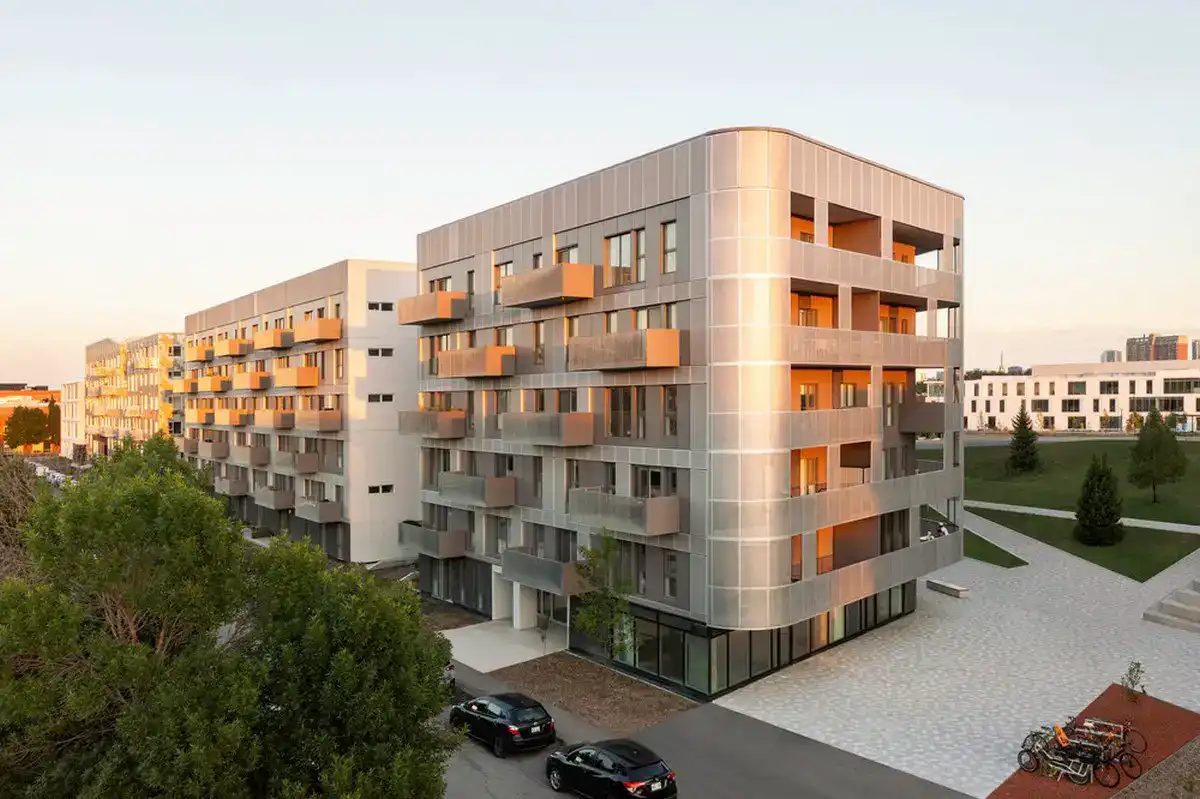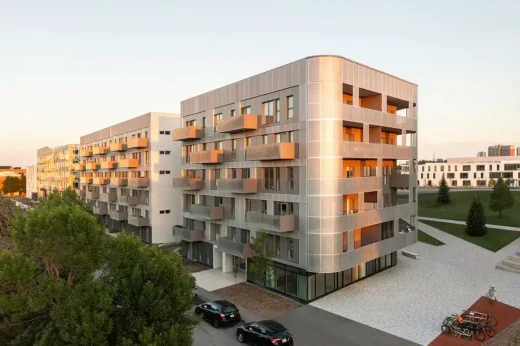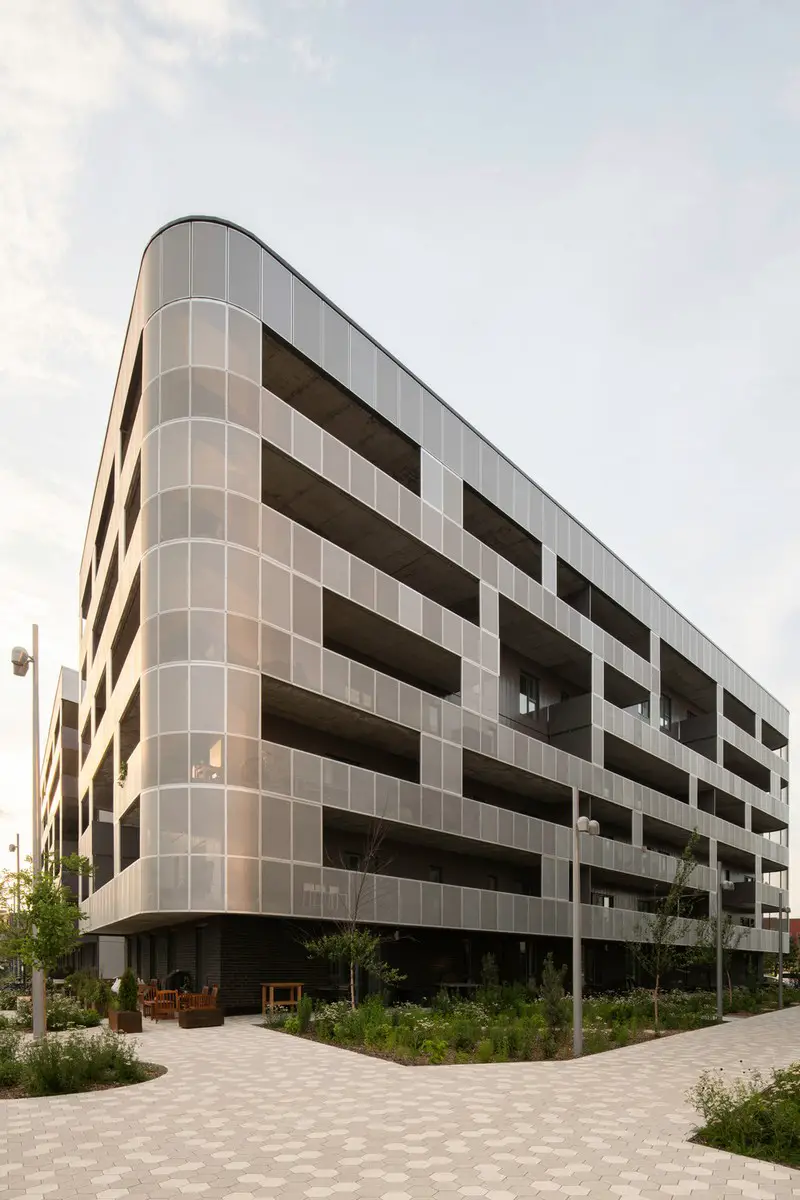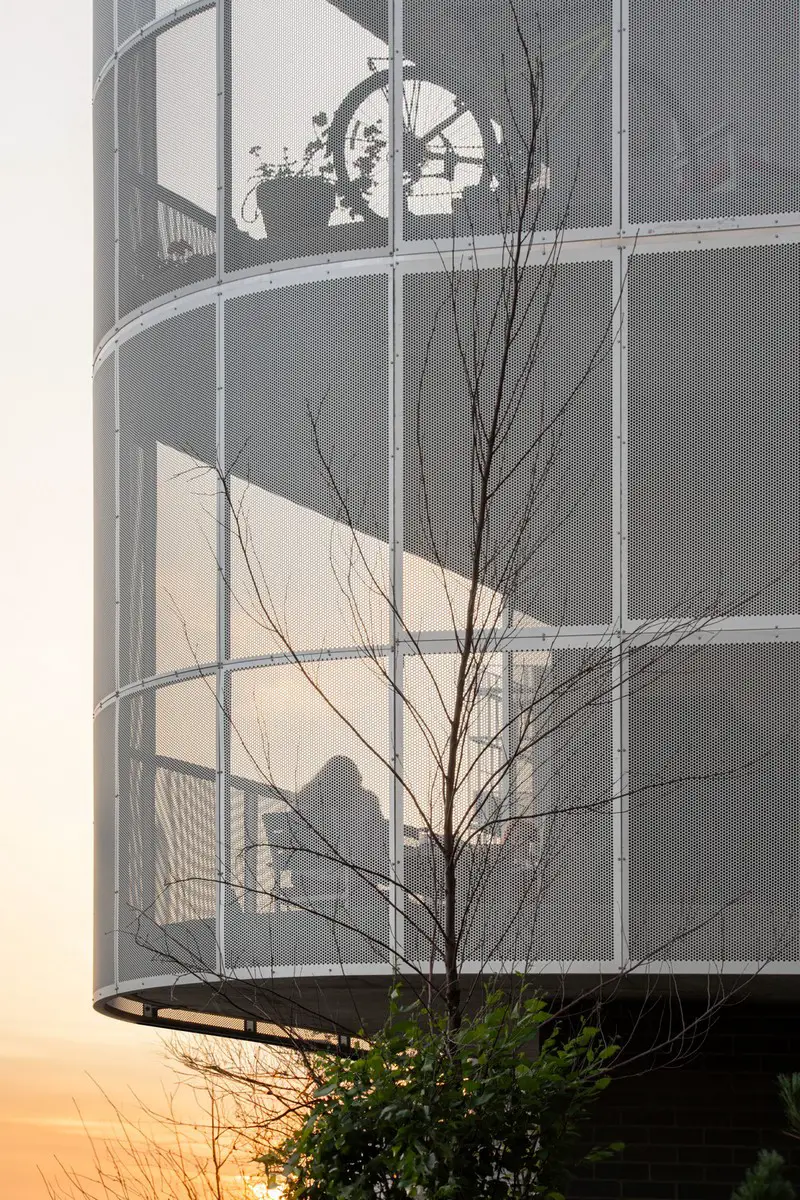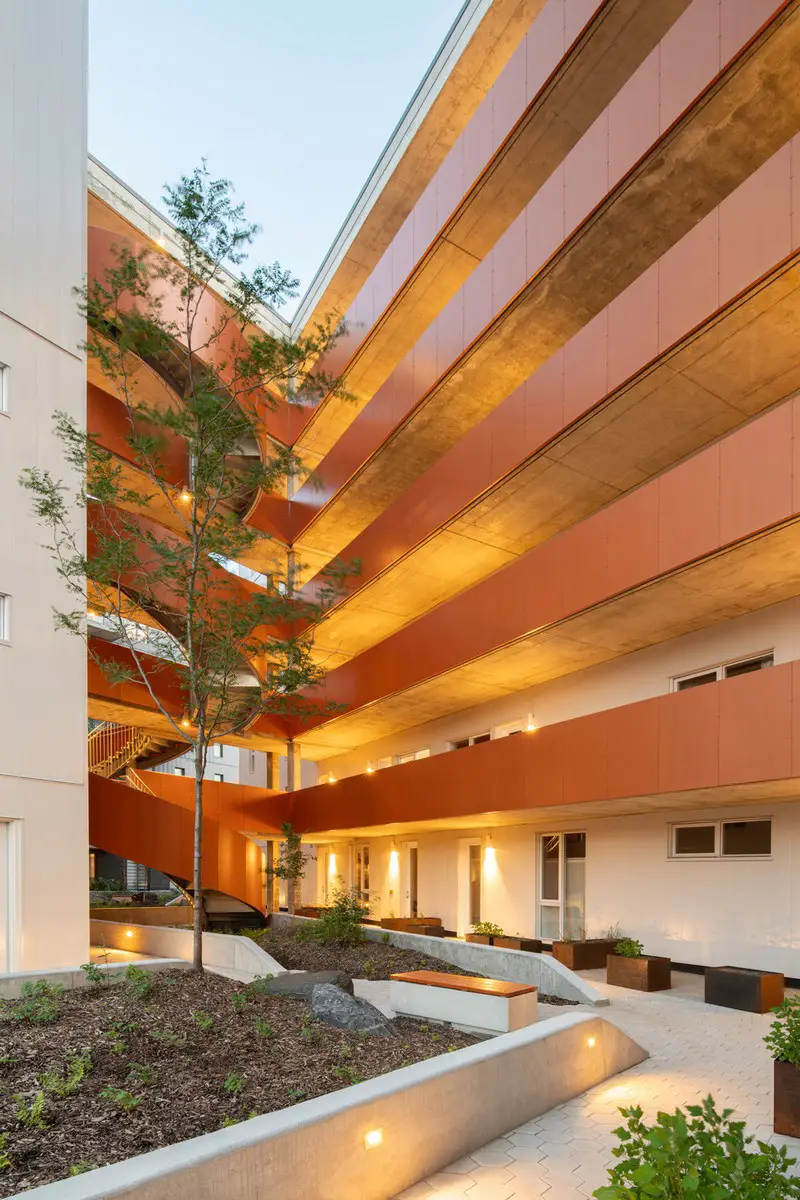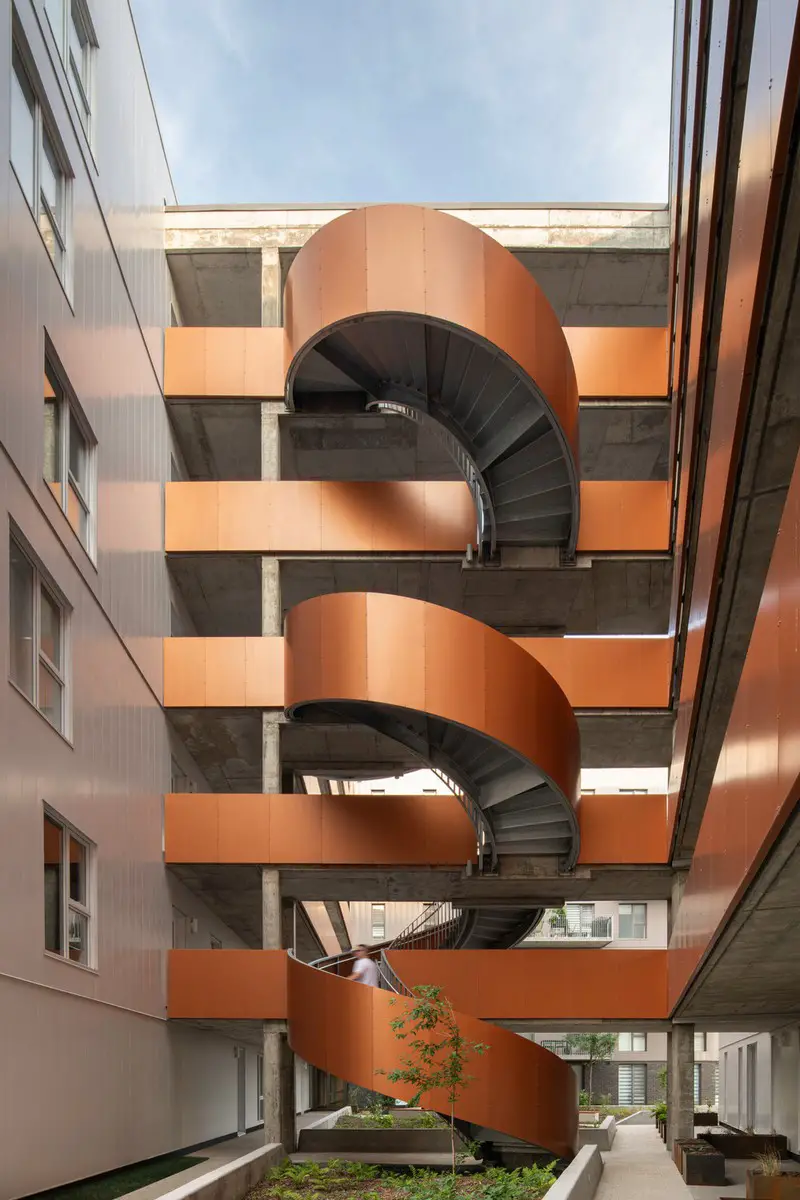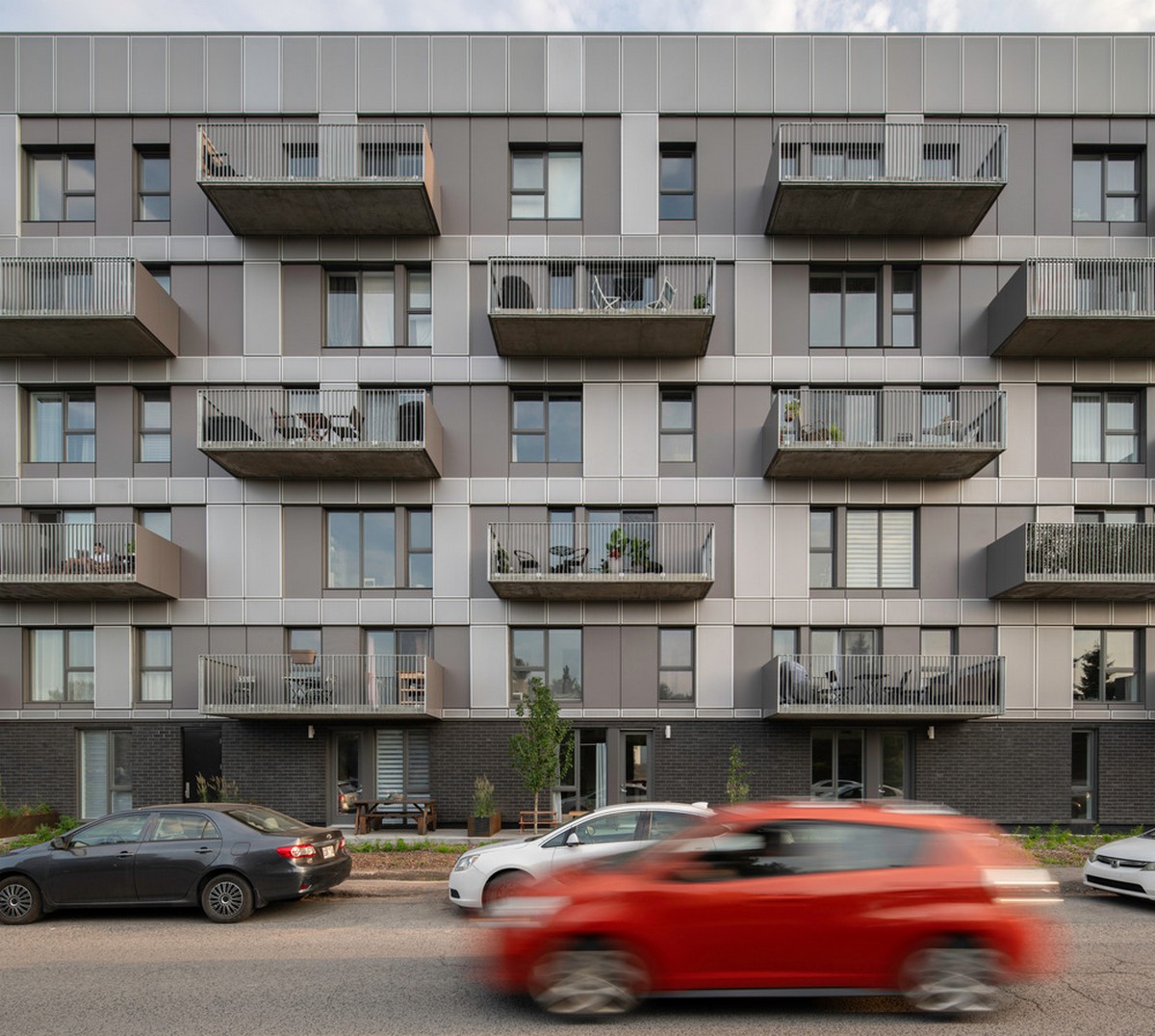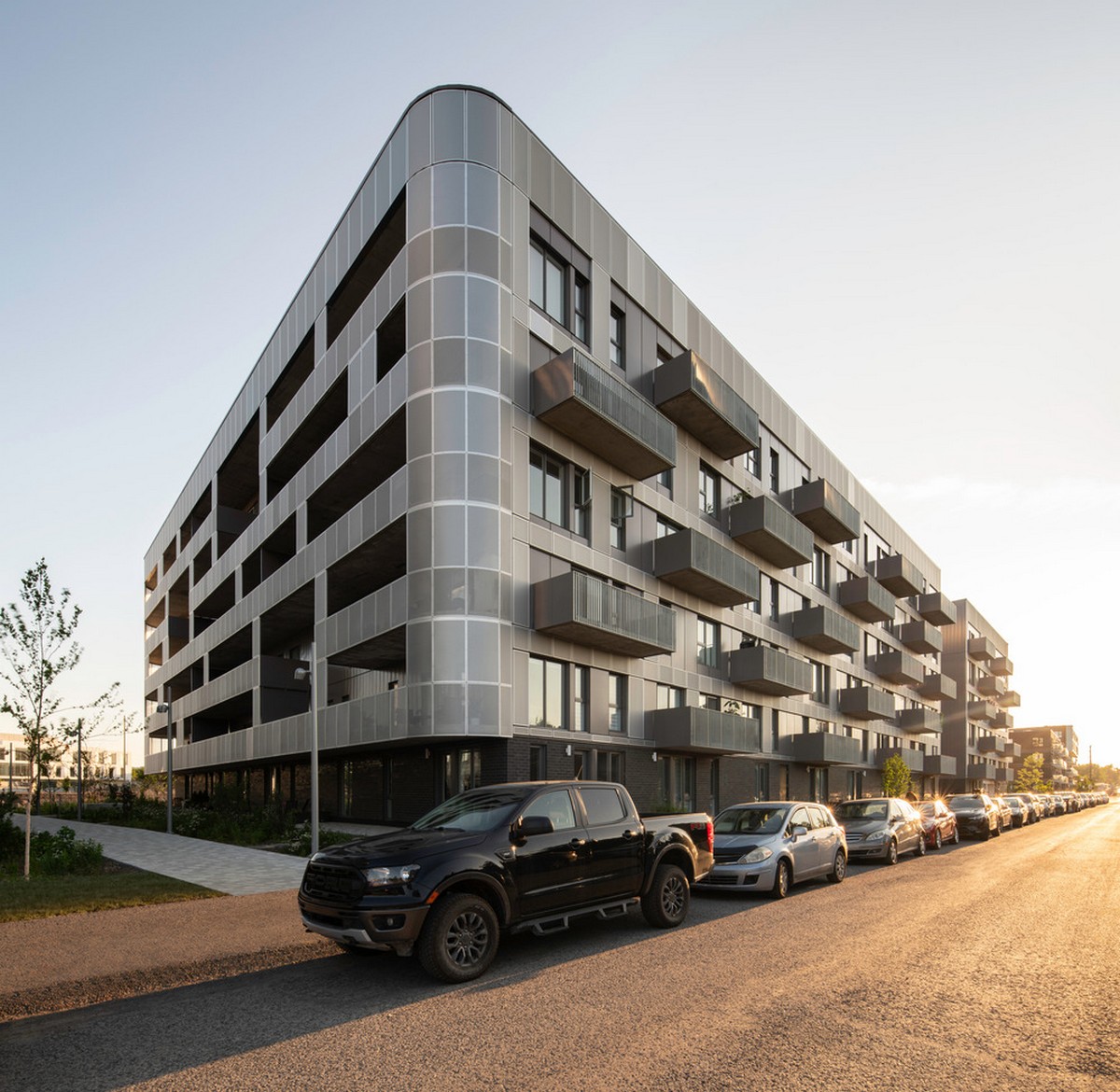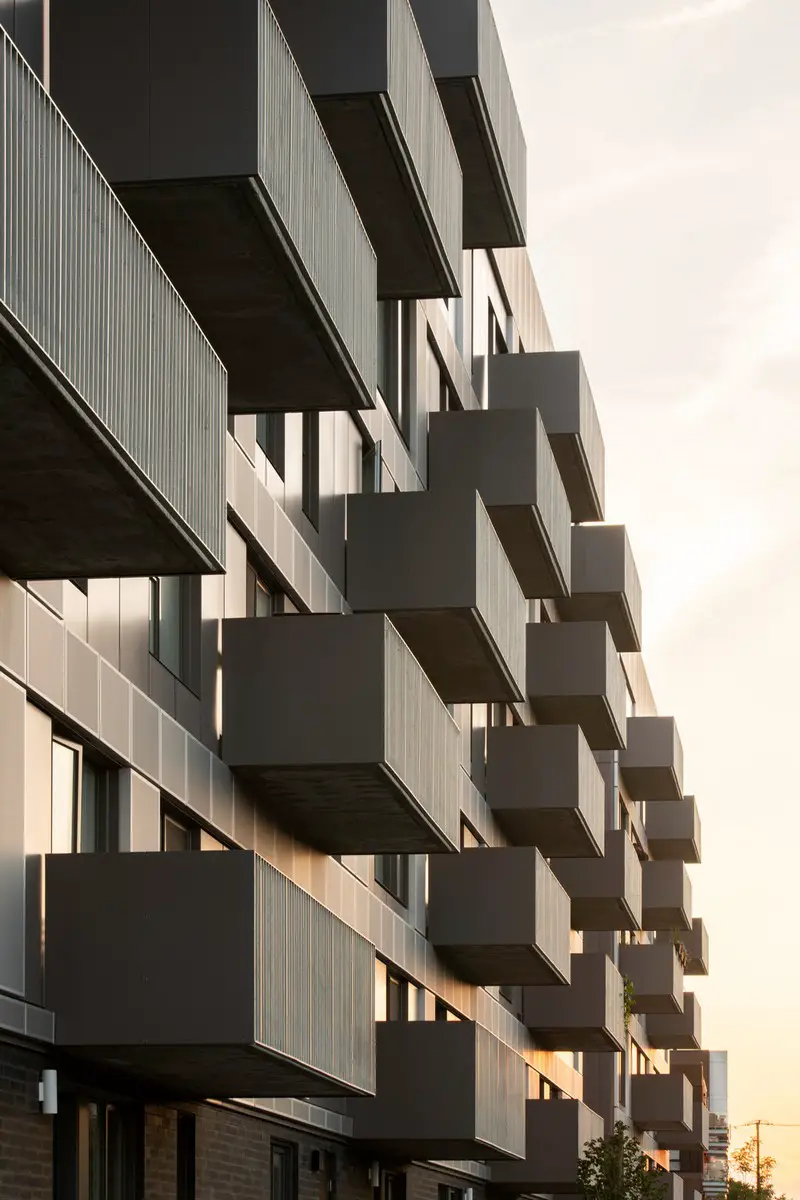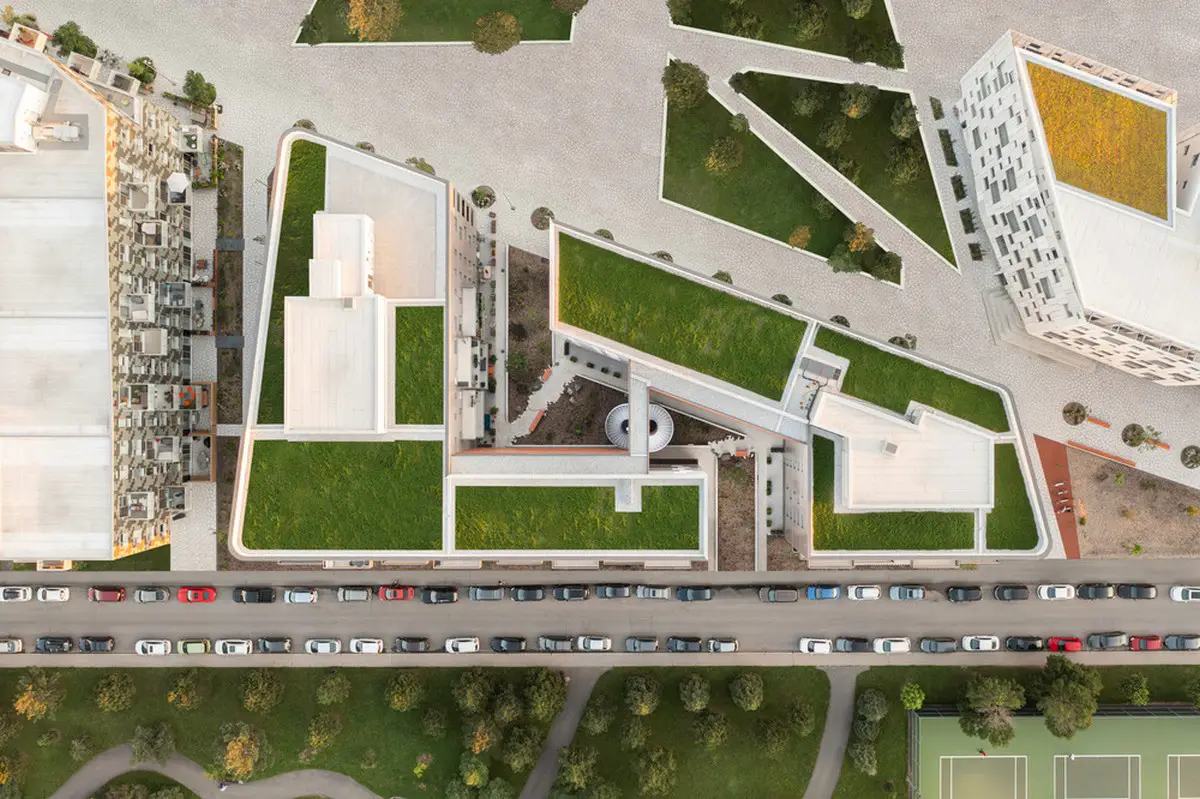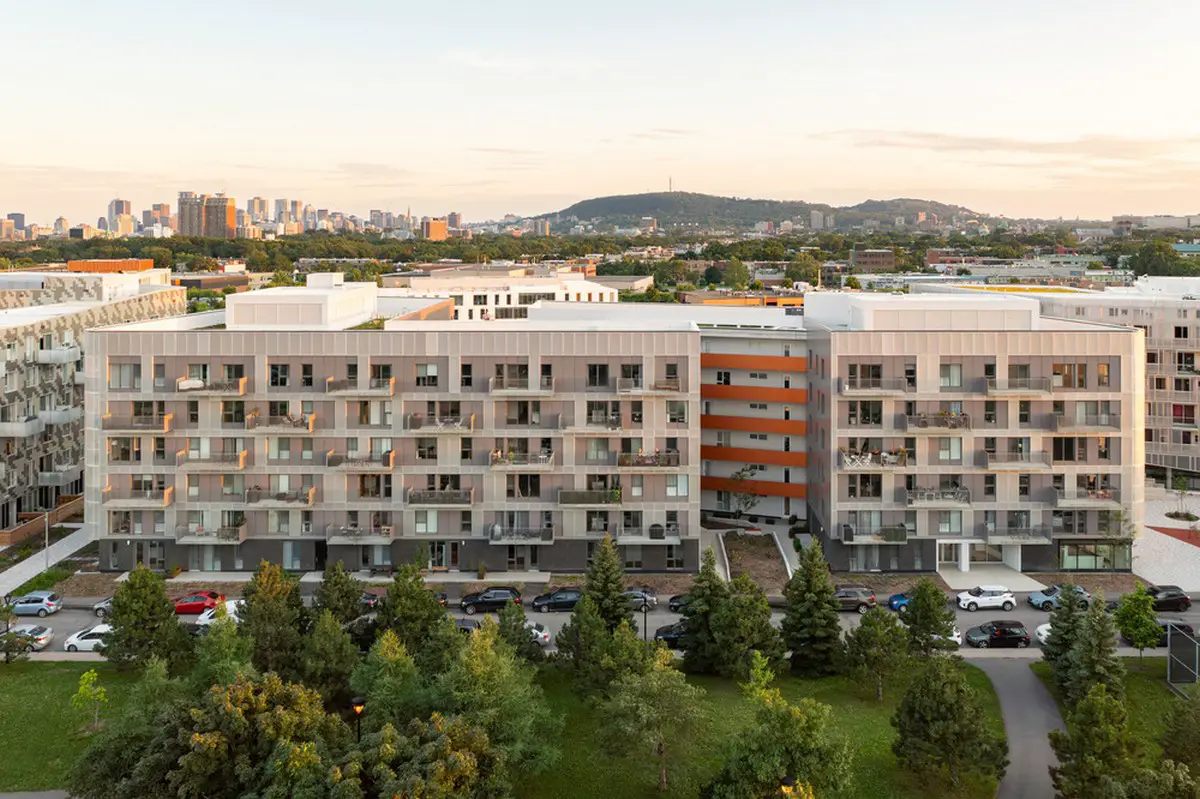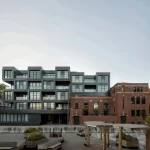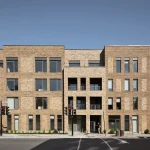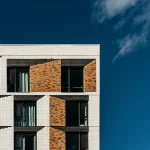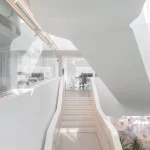Cité Angus II Housing Montreal, Québec multi-residential project, Canadian real estate images
Cité Angus II in Montreal
20 March 2024
Architects: Ædifica
Location: Rosemont-La Petite-Patrie district, Montréal, Québec, Canada
Photos by David Boyer Photographe
Cité Angus II Housing, Québec
Ædifica presents Cité Angus II, a multi-residential project located at the head of the central block of the Technopôle Angus, an urban requalification project orchestrated by the Société de développement Angus (SDA). Located on the outskirts of Montreal’s Rosemont-La Petite-Patrie district, the Technopôle Angus is part of an integrated approach to sustainable development, revitalization, and access to home ownership for families wishing to settle in the heart of the city.
The district features a mix of green spaces, public squares, restaurants, local shops and services, office space, and residential buildings. Certified LEED Neighbourhood Development Platinum, the Technopôle is a humble, local response to the contemporary challenges of Housing shortages and the exodus of families to the Montreal suburbs.
The Block 4 project, known as Cité Angus phase II, is a 6-storey building comprising 88 condominium units, including two small commercial premises on the first floor facing the public square. The heterogeneity of the surrounding building context, the desire to offer each building its own identity, combined with a dense program to be implemented on a cramped site with an atypical shape, are a summary of the project’s major challenges, transformed into an opportunity for innovation in the treatment of the various residential interfaces.
Completed in 2023, the project is now aiming for LEED for Homes Gold certification. From the choice of site layout and massing to the selection of materials and electromechanical systems, the project has been designed with a constant eye to sustainability, but also with a strong commitment to prioritize the quality of life of the community it serves. The project adheres to the principles of land development based on well-being and sharing. Achieving a critical density enables implementing strategies to save energy, consolidate alternative transportation, and develop community facilities, all of which are necessary for the socio-ecological transition.
The building takes the form of two volumes facing each other, giving way to an inner courtyard running through its center. The integration of this courtyard with its pedestrian walkway, private spaces, and landscaping at the heart of the project allows permeability with the urban fabric, encouraging human appropriation at the center of the site without compromising the program’s minimum density objective. This green space, at once intimate and public, contemplative and appropriable, is a fertile breeding ground for exchanges and social interaction between users. It offers a flexible, safe environment conducive to the informal encounters intrinsic to an inclusive community. From the interior courtyard, visitors can discover a monumental spiral staircase at the center of a network of exterior passageways, extending across all floors. This architectural staircase and the passageways naturally encourage active mobility, enabling residents to access their homes directly from the public space. These design choices, maintained throughout the project’s development, support the project’s main guidelines: density, diversity of residential typologies responding to evolving needs, access to natural light and quality views, biophilia, and the integration of outdoor spaces on the scale of today’s families.
To contribute to the achievement of all design objectives, the building envelope was designed to offer two distinct treatments, depending on its location: on the exterior facades, directly interfacing with the urban context, and on the facades facing the interior courtyard. On the exterior facades, a perforated, diaphanous second skin of metal, inspired by the district’s industrial heritage, follows the rhythm of the balconies. To maximize the building’s openness to Parc Jean-Duceppe, the metal mesh applied close to the building envelope runs along and enlivens the façade, punctuated by balconies projecting onto Rue Augustin-Frigon. On the other façades facing outwards from the site, the same metal mesh is completely detached and moves away from the exterior wall envelope, giving way to a network of continuous corridors and balconies that extend around the entire perimeter of the building. This double skin acts as a railing for the generous balconies, ensures privacy for residents, and helps to energize and enrich the architectural tectonics of the project.
On the façades facing the inner courtyard, the continuous walkways clad in a second skin are interrupted to maximize the amount of natural light entering the apartments. By removing the second skin formed by the perforated metal mesh, the first skin is revealed, exposing the splitting of the building into two distinct volumes, revealing the heart of the project and its own identity. The light-coloured metal cladding of the envelope, and the bright copper colour of the railings on the walkways in the inner courtyard, contrast with the more sober, monochrome materiality of the public interfaces. This contrasting choice maximizes luminosity in the inner courtyard. The dynamism of this space revealed between volumes is enhanced by the combination of individual balconies distributed in staggered rows, animating the transitional facades between exterior and interior, all reinforced by the presence of the central staircase. The materiality of the staircase, coloured with a metallic coating reminiscent of the industrial character of corten steel, present elsewhere in the Technopôle Angus, gives it a distinctive character reminiscent of the spiral staircases of typical Montreal backyards.
The development of the housing units has been designed to ensure the versatility and adaptability of the spaces and to reflect the great diversity of today’s family needs, accentuated by the transition in family-work balance models during the pandemic. Throughout the building, some units are on 2 levels, some are walk-through, some are accessible via the exterior corridor system, and others via a central interior corridor served by an elevator. All have been developed with a constant concern for equity, accessibility, and inclusion, for access to a healthy, efficient, and sustainable environment. These human values guiding development decisions are supported by the use of local, sustainably sourced, low-contaminant materials, and the integration of water- and energy-efficient equipment.
The heating and cooling system, both private and common to the building, is connected to an energy loop, ensuring exchanges of thermal loads between all the buildings forming part of the Îlot Central ecosystem. This loop linking all the buildings in the eco-neighborhood will ultimately reduce the greenhouse gas emissions associated with heating and air-conditioning in the overall project by 26%. These innovative strategies are a direct response to the sense of urgency in the face of the climate crisis.
The project is thus part of an integrated vision of densification of the urban fabric, and an inspiring example of sustainability and social innovation, essential in a contemporary social context where every sensitive intervention can make a difference.
Cité Angus II Housing in Rosemont-La Petite-Patrie district, Montreal – Building Information
Architect and Interior Designer: Ædifica – https://aedifica.com/
Client: Société de Développement Angus
General Contractor: Sidcan
Civil, Mechanical & Electrical Engineering: Desjardins Experts Conseils
Energy loop: Energere
Fire Protection Services: Les Services de P.I. CP inc.
Landscape Architecture: NIP Paysage
LEED for Homes Consultant: Écohabitation
Structural Engineering: Leroux+Cyr
Net Surface Area: 38 000 sqm
About Ædifica
Founded in 1985, Ædifica is a diversified collective dedicated to enriching human life through the creation of sustainable, carbon-neutral, and inspiring places. Ædifica creates memorable experiences for its clients, users, and communities committed to living on a healthy planet.
Its main sectors of activity are: workplace, retail, housing, mixed-use projects, education, culture, healthcare, sports, transportation/mobility, and cities. The main services include sustainability, architecture, interior design, urban planning, and engineering.
Photographs: David Boyer Photographe
Cité Angus II Housing, Montreal, Québec images / information received 200324 from v2com newswire
Location: Rosemont-La Petite-Patrie district, Montréal, Quebec, Canada
Montréal Housing Developments
Architects: Sid Lee Architecture | Canora
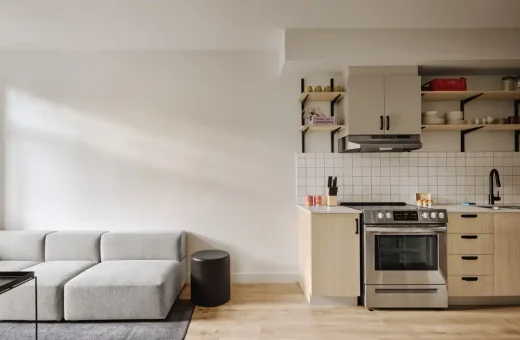
photo : Alex Lesage
Le Within Student Housing
Affordable Student Housing
Architects: ADHOC
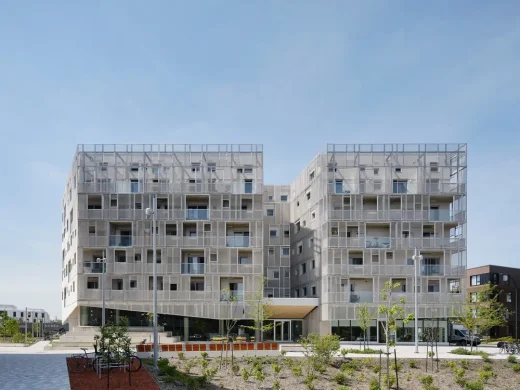
LINK Apartment Tower
Architects: ACDF Architecture
LINK Apartment Tower
Le Rosaire, 7671 rue Saint-Hubert
Architects: Fugere Architecture
Le Rosaire, Montréal Housing
Mellem Ville-Marie Apartments
Architects and Interior Designer: ADHOC
Mellem Ville-Marie Apartments
Montréal Architecture Developments
Contemporary Montréal Buildings
Montreal Architecture Designs – chronological list
Montreal Architecture Tours – North American architectural tours by e-architect
Canadian Architectural Designs
Canadian Building Designs – architectural selection below:
Comments / photos for the Cité Angus II Housing, Montreal, Québec housing design by Ædifica page welcome.

